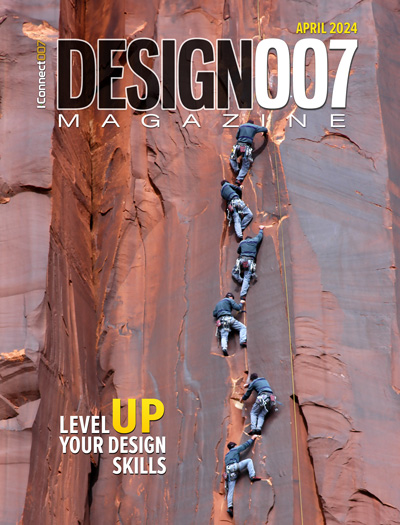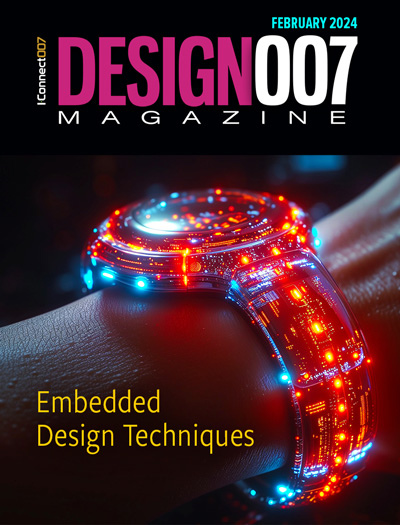-

- News
- Books
Featured Books
- design007 Magazine
Latest Issues
Current Issue
Level Up Your Design Skills
This month, our contributors discuss the PCB design classes available at IPC APEX EXPO 2024. As they explain, these courses cover everything from the basics of design through avoiding over-constraining high-speed boards, and so much more!

Opportunities and Challenges
In this issue, our expert contributors discuss the many opportunities and challenges in the PCB design community, and what can be done to grow the numbers of PCB designers—and design instructors.

Embedded Design Techniques
Our expert contributors provide the knowledge this month that designers need to be aware of to make intelligent, educated decisions about embedded design. Many design and manufacturing hurdles can trip up designers who are new to this technology.
- Articles
- Columns
Search Console
- Links
- Events
||| MENU - design007 Magazine
Max Maxfield Looks at the Future of Electronics
July 13, 2015 | Andy Shaughnessy, PCBDesign007Estimated reading time: 17 minutes
Clive “Max” Maxfield has worked for decades in this industry, and in a variety of capacities: Engineer, author, editor, columnist, blogger, and keynote speaker, just to name a few. I caught up with my former columnist recently and asked him what he’d been doing to stay out of trouble, and what sort of technology and futuristic electronic gadgets were piquing his interest right now.
Andy Shaughnessy: Good to talk with you again, Max. Why don’t you start out by giving us a little bit of your background.
Max Maxfield: Hi, Andy. It's great to catch up with you also. My background? Well, I graduated high school in the summer of 1975, which was notable for several reasons, including: The band 10cc released the classic I'm Not in Love; I saw Pink Floyd perform Dark Side of the Moon live at the Knebworth open-air festival; and we had two weeks of blue skies with no clouds. The people in England are still talking about it—I was born and bred in the county of Yorkshire, so I was 20 years old before I saw the sun for the first time.
At the end of that summer, I started a four-year electronics course at Sheffield Hallam University, but I quickly realized that it was more academic than I was looking for. We were spending a lot of time doing things like calculating the angular momentum of electrons, which is something I think you can do in the privacy of your home if you are so inclined. For myself, I wanted to work with rockets and robots; so, after the first year, I transferred to a four-year BSc degree course in control engineering, which had a core of mathematics and "surrounding subjects" of electronics, mechanics, and hydraulics/fluidics.
After I graduated in 1980, my first job was as a member of a team designing CPUs for mainframe computers at International Computers Limited (ICL), which was the UK's equivalent of IBM, but much smaller, of course.
Looking back, it truly is amazing how much things have changed. At that time we were designing ASICs containing only 2,000 logic gates, and we were doing so at gate/register-level schematics using pencil and paper. Functional verification involved you and your colleagues sitting around a table looking at your schematics—you explained what your logic was supposed to do and they either agreed or offered suggestions. Timing analysis involved you deciding on the critical paths and then adding up all of the delays by hand. Basically, I predate electronic design automation (EDA) as we know it.
Eventually, two of the managers left ICL to form their own company, and they invited me and a couple of other guys to join them. This led to me learning about digital logic simulation, which led to me traveling around the world giving training courses in simulation, which led to me writing magazine articles and speaking at conferences, which led to me moving to Huntsville, Alabama, USA, in 1990 to take a position with Intergraph Corporation. Intergraph's electronics group eventually split off as VeriBest, which was subsequently acquired by Mentor Graphics.
My father passed away in 2000. He was 84 and I was 42, which seemed symbolic at the time, so I and a couple of friends formed our own little company providing high-tech marketing consulting. Eventually, we put all of our money into a project that failed, so they went off to get real jobs and I became a freelance consultant. Then, a couple of years ago, I was offered a job with UBM as one of the editors at EETimes.com, which led me to my current position.
Shaughnessy: You rose to fame within the electronics industry with your book “Bebop to the Boolean Boogie,” which was adopted by Yale and a variety of other colleges. What made you decide to write a book? How many have you penned so far?
Maxfield: Well, I love reading for a start. I really like science fiction and fantasy, and I also really like graphic novels (see Gobsmacking Graphic Novels and Alex + Ada; A future that may be closer than you think). In addition to technology in general, I also enjoy learning about math, physics, chemistry, and biology, just so long as they are written in a fun and friendly style. I get bored really quickly with dry-as-dust writings.
When I awoke one Saturday morning back in the mists of time we called 1992, I was planning on visiting a local bookstore, but then I thought it would be fun to one day see a book of my own on the bookstore shelf, so I powered up my computer and wrote "Now sit up and pay attention, because this bit's important." Then I sat back and thought "What am I going to write about?" The two things I knew the most were electronics and computers. I hated it when I was at university and I waded through book after book, none of which seemed to have the information I was looking for, so I ended up writing Bebop to the Boolean Boogie (An Unconventional Guide to Electronics), now in its third edition, which is jam-packed with nuggets of knowledge and tidbits of trivia, and which stands proud to this day as the only electronics book to feature a recipe for seafood gumbo.
Remember that this was before the Internet as we know it today, so I basically spent two years of evenings and weekends at the local library where they had a copy of the Encyclopedia Britannica that I could use to check dates and facts. When I finished and sent it off to the publisher, I thought I'd never do anything like that again. But when I started watching television for the first time in two years, I quickly realized that I'd go insane if this was all I did, so I started work on the sequel, and things just kept on rolling along. (There's a list of Max's books thus far at the end of this article.)
Shaughnessy: Tell me about your “day job.” What are you doing to stay out of trouble?
Maxfield: I tell you, I don’t think I've ever worked harder in my life. Is it just me, or do you find that things seem to be coming at you faster and faster and that you are constantly juggling too many things? The problem is that I can't juggle. Actually, that's not strictly true—I can juggle five fine china plates, but only for about one second.
So, I'm currently an editor with EE Times. My "beats" include the Programmable Logic Designline and the EE Life section. I'm also the editorial director over on Embedded.com.
But wait, there's more, because I'm now the technical content director for the Embedded Systems Conference (ESC). This year we're having three ESCs in North America. ESC Boston 2015 took place in May; ESC Silicon Valley 2015 is coming up July 20-22, and we'll close the year out with ESC Minneapolis 2015 November 4-5. Of course, by the time we get to ESC Minneapolis 2015, we'll already be working furiously on ESC Boston 2015.
I'm too young for all of this excitement. On the bright side, since I'm now in charge, I have a high level of confidence that my own papers will be accepted! At ESC Silicon Valley, for example, I'm hosting an RTOS Smackdown, discussing the use of Awesome Analog Meters, and considering The Future of Embedded Systems.
Shaughnessy: You’ve written quite a bit about programmables. What sort of cool technology are you seeing in the programmables space?Page 1 of 4
Suggested Items
IDTechEx Examines the Opportunities for Wearables in Digital Health
04/19/2024 | IDTechExIDTechEx’s report, “Digital Health and Artificial Intelligence 2024-2034: Trends, Opportunities, and Outlook”, covers this ongoing trend in the consumer health wearables market and includes analysis of the opportunities and roadmap for biometric monitoring.
ZESTRON Welcomes Whitlock Associates as New Addition to their Existing Rep Team in Florida
04/19/2024 | ZESTRONZESTRON, the leading global provider of high-precision cleaning products, services, and training solutions in the electronics manufacturing and semiconductor industries, is thrilled to announce the addition of Whitlock Associates to its esteemed network of sales representatives.
IPC Bestows Posthumous Hall of Fame Award to Industry Icon Michael Ford
04/18/2024 | IPCIPC honored the late Michael Ford, Aegis Software, for his extraordinary contributions to the global electronics manufacturing industry with the IPC Raymond E. Pritchard Hall of Fame Award at IPC APEX EXPO 2024. IPC’s most prestigious honor, the Hall of Fame Award is given to individuals who have provided exceptional service and advancement to IPC and the electronics industry. Ford, an industry leader and valued IPC volunteer, died suddenly in January 2024.
SEMI Applauds U.S. Chips Act Award for Samsung Electronics Facilities to Strengthen Domestic Semiconductor Supply Chain
04/17/2024 | SEMISEMI, the industry association serving the global electronics design and manufacturing supply chain, applauded the United States Department of Commerce’s announcement of a Preliminary Memorandum of Terms for an award under the CHIPS and Science Act to support the expansion of Samsung Electronics’ presence in Texas and the company’s development and production of leading-edge chips.
Northrop Grumman honors Calumet Electronics with Supplier Excellence Award
04/17/2024 | Calumet ElectronicsNorthrop Grumman Corporation has recognized Calumet Electronics during the company’s 2024 Supplier Excellence Awards for “exceptional performance and unwavering commitment to delivering with excellence.” Calumet is one of 70 suppliers recognized from across the globe. In its award category of “Supplier Strategic Excellence,” Calumet was honored alongside global corporations such as Amazon Web Services, Dell Technologies, and Eaton Corporation.


